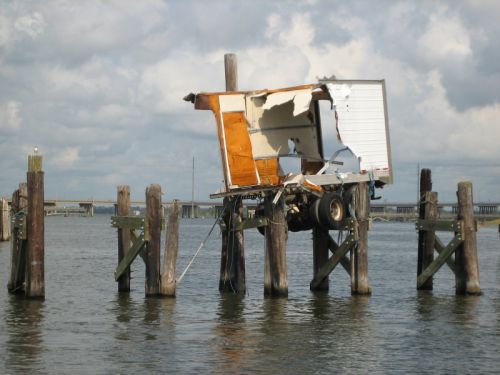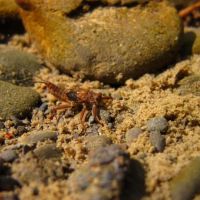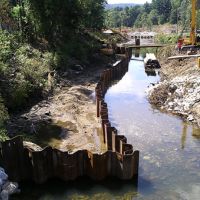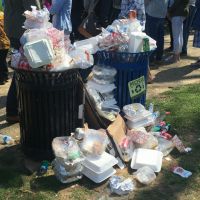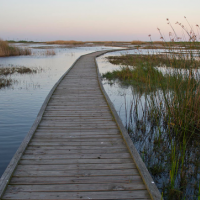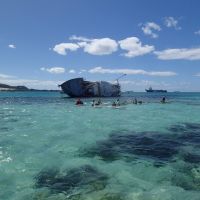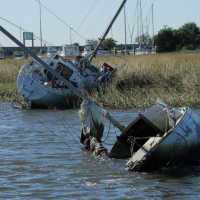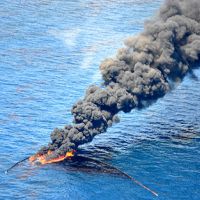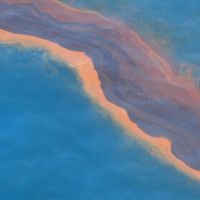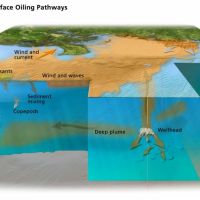When we think of natural resources harmed by toxic chemicals or oil spills, most of us probably envision animals like birds or river otters. But what about the tiny—but very important—creatures that live in the mud, sand, and stones at the bottoms of rivers? In polluted rivers, these little "bugs" can move contaminants up the food chain and have very serious impacts.
How Pollution Travels
Marine pollution comes in all shapes and sizes, and can travel through many different paths. This week, we're taking a closer look at how pollution, in its many forms, can travel far and wide—impacting natural resources and the people and wildlife that depend on them.
First, we'll take a look at how marine debris travels, and how ocean currents can create hotspots for the world's trash to accumulate. We'll also take a look at how debris travels during a disaster, such as a hurricane, and can wind up in some unique places.
We'll be exploring the age old question responders attempt to ask during an oil spill—"Where will the oil go?"—and the modeling tools we use to find the answer.
Then, we'll look back through history at how 20th century industrial pollution seemingly travels through time as it continues to plague America's waterways and ecosystems today.
After the pollution threat has been mitigated, restoration is often needed to help the natural resources recover or to create new resources for those that are lost. In celebration of Travel and Tourism Week, we'll take a look at some restoration sites worth visiting.
Stay tuned throughout this week and find out more below about how pollution travels.
Articles
For the United States, the 20th century was an exciting time of innovation in industry and advances in technology. Sometimes, however, technology races ahead of responsibility, and human health and the environment can suffer as a result. This is certainly the case for the toxic compounds known as polychlorinated biphenyls, or PCBs.
Learn more about How Pollution Travels
Just like people who travel around the world, our trash travels and it can go pretty far! Even if it’s dropped in an inland location, litter can easily become marine debris. Then it can move around the ocean, being pushed around by wind and currents, and traveling to far off locations, from remote islands to the depths of the ocean.
When an oil spill or other pollutant keeps people from enjoying a natural area, it’s up to agencies like NOAA, acting as public trustees of affected areas, to determine the impact of pollution on public recreation. It’s part of the Natural Resource Damage Assessment process which helps reach settlements with responsible parties to fund restoration.
When thinking about marine debris, you may picture trash in the ocean — plastic bottles, food wrappers, bags, and other everyday and single-use items that we come into contact with in our everyday life. However, the marine debris problem is much bigger than just our trash, especially when it comes to abandoned and derelict vessels.
Another hurricane season is upon us and with that, it’s time to think about how best to prepare for potential storms. Unfortunately, the wind, rains, and storm surge that can come with hurricanes can also result in a substantial influx of marine debris. Keep this point in mind when prepping your home for an upcoming storm.
Water pollution comes in many forms, from toxic chemicals to trash. The sources of water pollution are also varied, from factories to drain pipes. In general, OR&R classifies water pollution into two categories; point source and non-point source pollution.
Oil spills raise all sorts of scientific questions, and NOAA's job is to help answer them. We have a saying that each oil spill is unique, but there is one question we get after almost every spill: Where will the oil go?
When the Deepwater Horizon well blowout happened in 2010, OR&R specialists used their workhorse oil spill trajectory model, GNOME—first developed in the late 90s—to estimate where the oil from the gushing wellhead would end up.
In this 2021 blog, volunteers find an interesting piece of marine debris while cleaning up trash. Drift cards were once used to help track how pollution moves in the ocean, and in the case of these two cards, they moved thousands of miles away from where they were released.
 An official website of the United States government.
An official website of the United States government. 
